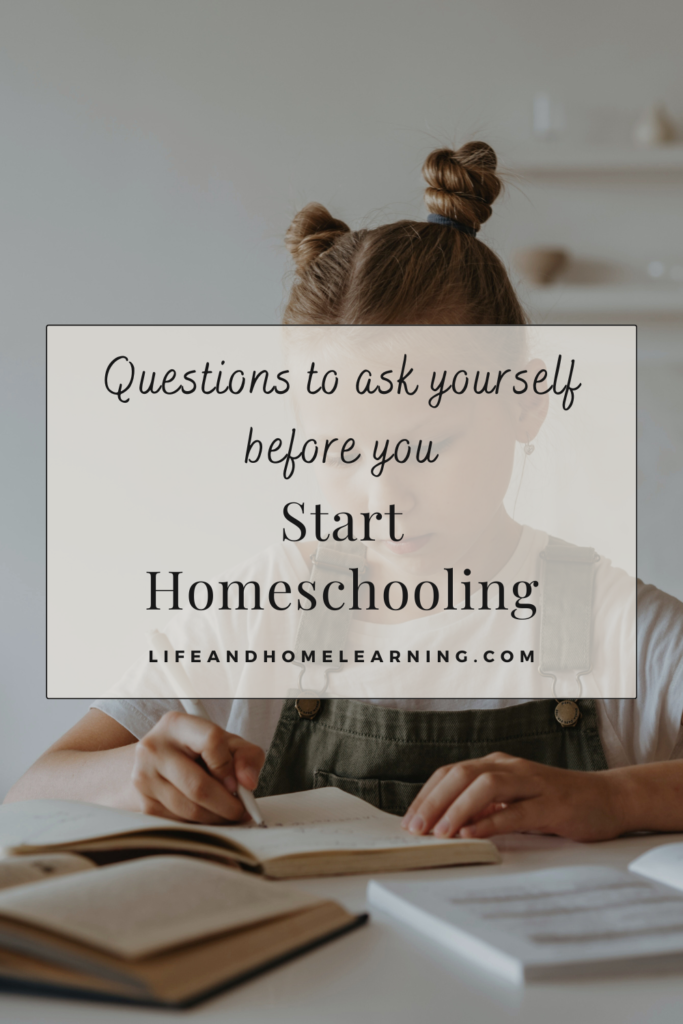How to Start Homeschooling
Are you considering homeschooling but aren’t quite sure where to begin? Take a look at the steps below to learn how to take the first steps to start homeschooling!
Think about the questions below to help you form an idea of the what, when, where and how you’d like to homeschool!
Join our brand new Facebook group!
Help build and become part of a community of homeschoolers where you can share resources, ideas, and advice!
Also check out:
What is Needed to Start Homeschooling
Step 1 – Check Your State’s Homeschooling Requirements

The first step in beginning homeschool is to definitely check your state and school district requirements!
We live in Nevada and homeschooling is very relaxed here! But every state has different requirements you must meet in order to homeschool.
Some states require record keeping, state testing, submission of forms, required hour logs and possibly more! My state has none of these requirements besides filling the initial paperwork, but definitely check your states requirements.
Check out this organization that is dedicated to homeschoolers for more info on your state’s regulations: Home School Legal Defense Association.
Step 2 – Decide On Your Methods


Ask yourself what you want your homeschool to look like and how you want to conduct your time!
Will you be the relaxed, hanging out in your pajamas all day homeschooler? Will you have a morning routine or a specific schedule your family will follow?
How many days and how much time are you wanting to do school, and what subjects are you wanting to cover? (Your state might have specifications on required time and subjects as well!)
Where are you considering conducting your homeschool? A designated homeschool room? At the kitchen table? Maybe just sitting on the couch? How about in the yard or at the park? The freedom to choose is yours!
Also, know that it is totally okay if your homeschooling style changes! And, it is totally okay if your homeschooling style ends up not looking exactly like what you had imagined!
Click here to see Our Homeschool Breakdown which goes into our day and week schedule and more!
Step 3 – Choose your curriculum

This might seem daunting at first as there are SO many options out there. Here are some questions you might ask yourself:
Do you want to use an online curriculum, physical curriculum or a combination of both? Or are you going to create your own curriculum?
Do you want the curriculum to be a spiral approach or a mastery approach?
Spiral approach
Student learns a little bit on a concept, then moves on to another and another. The first concept learned about will “spiral” back around and dig a little further.
This approach is great for kids who get bored with learning about one concept for too long. This approach also has tons of built in review and so the child is less likely to learn a concept and forget about it.
Mastery approach
The focus is on one concept and the child will thoroughly learn about that concept until the child reaches “mastery” understanding. Then they move onto the next concept, with little review of the previous learnt concept.
This approach is great for a student who benefits from digging deep into a concept before moving on. Sometimes this can be a good option if a student is struggling with a certain concept as it allows more practice before working on another concept.
Are unit studies or group studies something your considering for some subjects?
Unit studies
Unit studies are focused studies about one topic. Usually seen in science, history, or geography. For example instead of just studying “zoology” you might study specifically about birds. Many unit studies dig much deeper than just surface level facts.
Group Studies
These are subjects that all your students can sit and do together as a group, even with varying grade levels. Usually seen in science, history, or geography.
Many times the group study curriculum will have “lesson extensions” for older grades or different workbooks designated for different grades. The core part of the lesson is taught the same to everyone though.
For example: If learning about birds, there will be a core lesson, and then students in different grade levels might have different questions they need to answer in their workbook. Lesson extensions will provide more information for older students who can understand more complex information.
*Most curriculum out there have sample lessons and I encourage you to try out a few! It’s a great way to get an idea of what that specific curriculum entails!
The main core subjects you’ll want to teach for sure are Language Arts and Math.
For early elementary, subjects like History and Science are more of an elective. But don’t hesitate to jump in to them if you or your child is interested! These “elective” subjects are sometimes the funnest and best way to help foster a love of learning in your child!
Don’t forget about Handwriting! I know some families who consider handwriting a core subject and some who consider handwriting an elective. Everything depends on you and your child!
Check out our Homeschool Curriculum Picks for 23′-24′
Step 4 – Gather supplies!

You really don’t need much! We have a ton of art supplies as we are a very hands-on family, but a fellow homeschooling friend of mine confessed that they don’t even own a bottle of glue! Our families are different in the way we homeschool and the supplies we use to do it, but all of our kids are thriving nonetheless!
Here’s a general list of the things we use nearly everyday.
- Personal white board
- Dry erase markers
- Pencils
- Lined paper or notebook
- Scissors
- A computer or smart device.
… besides your curriculum, that’s all you really need!! Everything else is just extra!
Step 5 -Decide when to start!

When do you want to start? Do you want to follow your local school’s academic schedule? Do you want to start a little earlier or a little later?
Maybe you want to do year-round schooling?
This is totally up to you and your family!
I personally like to start our school year a little early so that we can take more time off throughout the school year.
We also do light summer homeschool! This really just consists of doing a review math lesson here and there and reading tons of books! Easy Peasy and they don’t forget everything they learned over summer break!
Have I mentioned that I LOVE the flexibility that homeschooling has afforded us? Homeschooling is freedom!
Step 6 – Be confident in your decision

Whether you choose to homeschool or not, learn to be confident in your decision! Your child’s education is very important! Whatever you decide, just know that you are an incredible parent/guardian for putting in the extra effort and considering all the options!
How to Start Homeschooling
I hope that something in this list has helped you in some way along your journey in educating your child(ren)!
Check out some related Homeschool Articles:
What is Needed to Start Homeschooling
5 Reasons Why to Not Homeschool
Homeschooling Myths and Misconceptions
Homeschool Curriculum Picks for 23′-24′
Join our brand new Facebook group!
Help build and become part of a community of homeschoolers where you can share resources, ideas, and advice!



